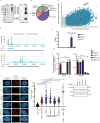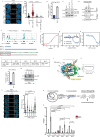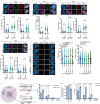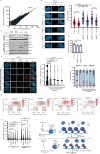NEAT1 modulates the TIRR/53BP1 complex to maintain genome integrity
- PMID: 39349456
- PMCID: PMC11443056
- DOI: 10.1038/s41467-024-52862-w
NEAT1 modulates the TIRR/53BP1 complex to maintain genome integrity
Abstract
Tudor Interacting Repair Regulator (TIRR) is an RNA-binding protein (RBP) that interacts directly with 53BP1, restricting its access to DNA double-strand breaks (DSBs) and its association with p53. We utilized iCLIP to identify RNAs that directly bind to TIRR within cells, identifying the long non-coding RNA NEAT1 as the primary RNA partner. The high affinity of TIRR for NEAT1 is due to prevalent G-rich motifs in the short isoform (NEAT1_1) region of NEAT1. This interaction destabilizes the TIRR/53BP1 complex, promoting 53BP1's function. NEAT1_1 is enriched during the G1 phase of the cell cycle, thereby ensuring that TIRR-dependent inhibition of 53BP1's function is cell cycle-dependent. TDP-43, an RBP that is implicated in neurodegenerative diseases, modulates the TIRR/53BP1 complex by promoting the production of the NEAT1 short isoform, NEAT1_1. Together, we infer that NEAT1_1, and factors regulating NEAT1_1, may impact 53BP1-dependent DNA repair processes, with implications for a spectrum of diseases.
© 2024. The Author(s).
Conflict of interest statement
The authors declare no competing interests.
Figures






References
-
- Bryant, H. E. et al. Specific killing of BRCA2-deficient tumours with inhibitors of poly(ADP-ribose) polymerase. Nature434, 913–917 (2005). - PubMed
Publication types
MeSH terms
Substances
Associated data
- Actions
- Actions
Grants and funding
LinkOut - more resources
Full Text Sources
Research Materials
Miscellaneous

